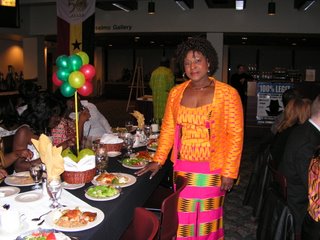Recipe #3: Pot Luck Gari foto
 Last Sunday for a fellowship meal at church I made some gari foto (Americans would say "Gary PHOto") a one-pot dish that's hearty, quick and easy and inexpensive to prepare, and a new (but not too new--Ghanaian gari has a mild taste that is quite acceptable and accessible to North Americans) flavor combination. Basically, one whisks and cooks a couple of eggs as you would for Chinese fried rice, sets them aside and makes a simple stew of oil, chopped onions, garlic, ginger, tomatoes and red pepper (and, if you like, something like canned corned beef, or tuna or sardines, or any other leftover meat or fish; I imagine tofu would work, too), and mix it together with some gari that has been pre-moistened. If you are not near a market that sells African ingredients, locate one online that will ship it to you.
Last Sunday for a fellowship meal at church I made some gari foto (Americans would say "Gary PHOto") a one-pot dish that's hearty, quick and easy and inexpensive to prepare, and a new (but not too new--Ghanaian gari has a mild taste that is quite acceptable and accessible to North Americans) flavor combination. Basically, one whisks and cooks a couple of eggs as you would for Chinese fried rice, sets them aside and makes a simple stew of oil, chopped onions, garlic, ginger, tomatoes and red pepper (and, if you like, something like canned corned beef, or tuna or sardines, or any other leftover meat or fish; I imagine tofu would work, too), and mix it together with some gari that has been pre-moistened. If you are not near a market that sells African ingredients, locate one online that will ship it to you.As I mentioned recently, gari is a form of cassava (aka, manioc, yuca) that has been soaked, grated, fermented, dried, and roasted to make a convenience food that is reminiscent of couscous and is gaining in popularity in urban areas of Western Africa. Gari is especially popular in Ghana and Nigeria. Another day I'll talk about a delightful cousin of gari from Côte d'Ivoire called attiéké.
Gari foto is also called gari jollof, and is similar to classic West African jollof rice, which is a one-pot stew and rice dish. The main difference is that gari foto is faster, since you don't have to wait for it to cook as you would rice. While it was once a humble end-of-the-week-leftovers dish, today it is just as likely to be served at dinner parties in Ghana.
I'm putting recipes up on this blog and hope you will try them out and send me feedback, but I've been advised that I should mention that each of these are original recipes and are copyrighted ;-) ©Fran Osseo-Asare, 2009
Basic Gari foto with Corned Beef (this is the way I most commonly make it)
1 onion, chopped
2 large fresh tomatoes, or 2 cups grape tomatoes, chopped (or 3 drained canned tomatoes, chopped), seeded if preferred
1/2 tin of canned corned beef (or about 6 oz., or 1 cup of any leftover fish, meat, or beans), in chunks
1 Tablespoon tomato sauce (optional)
6 Tablespoons of peanut or other vegetable oil
2 eggs, beaten
2 cups of gari
3/4 cup water
1/4 teaspoon salt
2 Tablespoons red palm oil (if available)
1 teaspoon fresh grated ginger (or 1/2 teaspoon dried ground ginger)
1/4 teaspoon ground red pepper (or to taste, or a little chopped fresh hot pepper)
parley for garnish, optional [that's a Western touch ;-)]
1 or 2 cloves of garlic, peeled and minced or pressed in a garlic press (optional)
Prepare ingredients: chop onion and tomatoes, grate ginger (if using fresh), peel and mince or press garlic (if using), open the corned beef can (if using), tomato sauce can (if using), break eggs in a bowl and beat well, measure out the gari in a separate bowl. Assemble other ingredients: oils, salt, ground red pepper, etc.
Measure out 3/4 cup of water and add a little (1/4 teaspoon) salt, and gradually sprinkle it over the gari, mixing it in with a fork (I usually just use my fingers so I can judge how wet it is). The gari should be dampened, but not dripping wet. Let the gari sit while you prepare the eggs and stew.
For a fancy version, you can fry a little of the chopped onion in a tablespoon of peanut or other oil, then mix a tablespoon of the tomato sauce into the beaten egg, and fry it as you would an omlett, then cut half of it into strips to garnish the finished gari foto (I usually omit this step for family meals, and just basically scramble the eggs and set them aside to break up and mix into the gari foto after mixing the gari in with the stew.)
After removing the eggs from the pan (I use a heavy cast iron skillet, but any heavy pan or pot will work), add the 2 Tablespoons red palm oil (this is called dende oil in Brazil, and there's a special spiced red palm oil from Ghana called zomi, if you can get it) and 1/3 cup, or 5 Tablespoons, peanut oil (or any other vegetable oil you like. Some Ghanaians have started using imported olive oil in cooking because they hear it is healthier, but that is not the traditional flavor). You can adjust the proportions of palm and peanut (or other oil, like canola) to taste. I usually use a light hand with the palm oil for those unfamiliar with it.
When the oil in the pan is hot, add the chopped onion and saute it until it is clear, then stir in the corned beef, if using. It will disintegrate as it cooks, which is good. After a minute or so, add the garlic, then the tomatoes, ginger, and red pepper. If you are using half of the egg mixture to garnish the dish keep it aside, then break the rest into small chunks, and stir into the stew. If you do not wish to garnish, add all of the egg into the stew. Turn the heat to low and mix in the gari mixture, using a fork to break up any lumps of gari. Keep turning it until the stew saturates the gari and there are no dry white (or yellow) lumps of the gari. Add salt to taste.
If desired, garnish the finished dish with fresh parsley and decorative egg strips.
Hints: Gari foto may be eaten alone or with a vegetable side dish, with a pepper sauce, or may be accompanied by a red bean stew.
A couple of teaspoons of dried ground shrimp may also be stirred in with the other seasonings to give it a distinctive West African flavor.
If you are leery of grating and chopping fresh hot pepper and/or ginger, just throw them into a blender with a little water and blend them together to add them. Remember that the more membrane and seeds you include from any hot pepper, the hotter it will be. I recommend using ground red pepper to have more control over the heat of this dish, which is usually not served spicy.
Enjoy.




